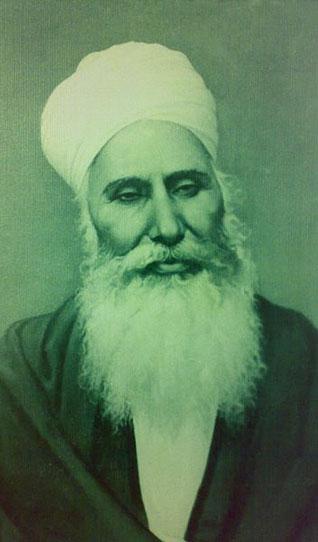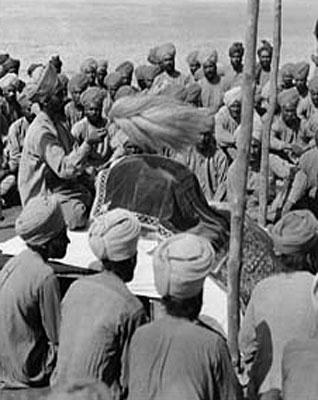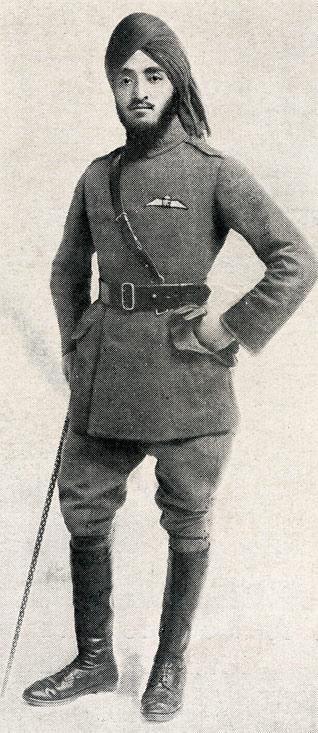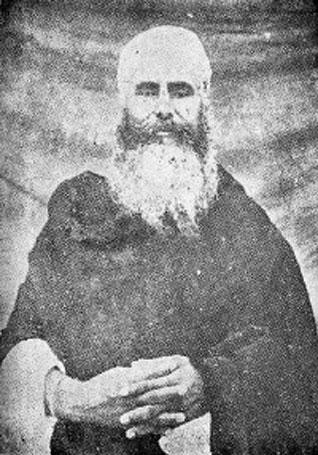
Above & below, first from bottom - Sant Attar Singh. Second from below - Ambassador and World War Flying Ace, Malik Hardit Singh. Third from bottom - Sikh soldiers conducting a Divan, early 1900s.



Our Heroes
Sant Attar Singh: A Great Soul
by MANPREET SINGH
After the annexation of Punjab to the British Empire in 1849, Christian missionary activity became a British priority and, before long, a large number of weak-minded Sikhs were converted to Christianity under the influence of the empire's missionaries.
The population of Sikhs declined to a mere 800,000 and the situation was so grim that, according to the British Government intelligence reports, there would be no Sikh in this world by the year 1900, if they were able to keep up this pace of conversion for a while.
At this critical time in the history of the Sikhs, Sant Attar Singh ji was sent to this world by the Almighty Waheguru to stem this tide of conversion of the Sikhs to Christianity.
With the Grace of Guru Gobind Singh ji, Sant Attar Singh inspired to Amrit-paan and introduced about 1.4 million persons back to the Sikh faith in his lifetime. The population of Sikhs grew to 4 million by the time Sant ji left this mortal world.
Sant Attar Singh, the most widely known and respected saint in modern Sikhdom, was born on 28 March, 1867, in the village of Chima in the erstwhile Jind State (now in Sangrur District of Punjab) to Baba Karam Singh and Mata Bholi Kaur.
From his very childhood, Attar Singh showed signs of his future greatness. He loved quiet meditation. Even at the age of five years, he is said to have remained engrossed in meditation for long periods. At the age of seven, the young lad was sent to a village school, but he respectfully replied that he would receive only that education which leads to realization of truth.
In 1885, young Attar Singh joined the army. He took Amrit from Panj Pyare led by Bhai Jodh Singh, an Elder in an army gurdwara. Under his guidance, Attar Singh devoted his time to studying the sacred Sikh books and meditating on the divine Naam. However, he remained active and up-to-date in his military duties and attained the first position in marksmanship.
News of his father's death moved him to immerse further into the Divine Realm at the earliest. He decided to leave the service by getting himself changed from active service to reserve category.
Then he proceeded on foot from Dera Ghazi Khan (now in Pakistan) to Takht Sri Hazur Sahib in Nanded (now in the Maharashtra State of India).
Guru Gobind Singh had breathed his last here in 1708, and the historical shrines commemorate his sojourn in the area.
Attar Singh spent about two years here. During this period, he engaged himself in simran and study. He is said to have spent days and night in uninterrupted meditation and recitation of the Naam.
From Hazur Sahib, he walked across the country to Hardwar and Rishikesh (in curent-day Uttar Pradesh State). He spent about a year in deep and prolonged meditation at Rishikesh.
From there, he again set out on foot, along with Bhai Ram Singh of Thamali for Sialkot (now in Pakistan) via Dehradun, Paonta Sahib, Baru, Anandpur Sahib, Una and Gurdaspur.
From Sialkot, he proceeded to Amritsar and meditated for three days on the third floor of Gurdwara Baba Atal.
Thereafter, he headed to his village, where he met his mother.
On the persistent request of Attar Singh, she gave her consent for allowing him not to marry, so as to enable him to be free to spend his life in the service of humanity and the Sikh Panth.
Attar Singh left his village, Chima, after three months. Since he was not formally discharged from the army as yet, he decided to submit himself before army authorities at Abbotabad in Rawalpindi district (now in Pakistan) for completing the formalities required for his final discharge from the military. The Colonel and Commanding Officer of his unit was appreciative of his services and tried to persuade him not to leave the army, but Attar Singh did not relent and was finally granted the discharge he had sought.
Thus, he became totally free to pursue the Divine Mission of his life.
On his way to Panja Sahib Gurdwara, he is said to have had a vision of the Ten Gurus.
From there, he went to Rawalpindi to meet Bhai Ram Singh. In consultation with him, he selected an isolated place in the forest near the village Kanoha for prolonged meditation.
After completion of an Akhand Path (uninterrupted recitation of the whole of Guru Granth Sahib), he resorted to lengthy meditation sessions - in three spells of forty days, six months and then one year, respectively.
During this period, he used to take a very small quantity of food once a day only, which was served by a devotee couple. As a result of these prolonged meditations, his body was reduced to a mere skeleton. It is from this point on that he became known as Sant ji.
His mother, Mata Bholi ji, developed an abscess near the knee joint which caused her a lot of pain and suffering.
Sant ji met her one evening and explained the spirit of tolerance and accepting the Will of God by concentrating on the Divine Naam. She thus had realization of spiritual gyan ("true knowledge") from her own son. This realization of one-ness with God enabled her to overcome physical suffering completely and attain an exalted spiritual stage of jiwan mukt (emancipation of the spirit in one's lifetime) during her last days. She died a peaceful and saintly death.
On the advice of Baba Sham Singh of Amritsar - an exalted and noble person - Principal Niranjan Singh of Khalsa College, Amritsar, met Sant Attar Singh at Lahore in 1905. Niranjan Singh took Amrit and was known thenceforth as Sant Teja Singh.
He dedicated his whole life to Sant Attar Singh ji in selfless service.
Sant Attar Singh then sent Teja Singh abroad for higher education and propagation of Sikhi. He completed his degree from Harvard University, and then went on to travel across Europe and America, spreading the Divine Message of Guru Nanak.
In 1911, King George V visited Delhi and a grand Delhi Darbar was held in the city. Maharajas of Sikh states requested Sant ji to lead the procession of Sikhs on this occasion. Seated on an elephant in the holy presence of Guru Granth Sahib, he sang Gurbani as his elephant passed by the British King.
The theme of the shabad was: "No King or Raja can be equal to Almighty God, because all these worldly rulers exist only for a very short span of time and indulge in falsehood".
On an enquiry by the King, the meaning of the Shabad was explained to him. On hearing about him, the King was very much impressed by the noble and radiant personality of Sant ji.
During a religious discourse at Gurdwara Bangla Sahib, Delhi, Sant ji was bitten by a poisonous snake. Despite the best possible medical treatment then available, Sant ji left his mortal frame on February 1, 1927 at Sangrur. He was cremated at Mastuana Sahib, five kilometres away, in the presence of a mammoth gathering of his followers and devotees.
Thus an era of religious revivalism in Sikh history came to an end. But his memory and achievements will ever remain alive in the hearts of millions of Sikhs and Punjabis.
Sant Attar Singh laid great emphasis on the spread of education and founded a large number of Sikh schools and colleges. He always insisted on education, blended with lofty principles of love, compassion, humility and the higher values in life.
He took an active interest in the affairs of The Sikh Educational Conference. On the request of the renowned Hindu leader, Pandit Madan Mohan Malviya, Sant ji laid the foundation stone of Banaras Hindu University at Varanasi in 1914.
Malviya was so impressed by the towering spiritual personality of Sant Ji that he, Panditji, thenceforth began to propagate that every Hindu family should have at least one member - the eldest son, he recommended - convert to Sikhism in order to improve and cleanse Indian society.
Sant ji helped in the construction of many gurdwaras and sarovars. He was responsible for constructing a magnificient building and sarovar at Gurdwara Damdama Sahib, Sabo ki Talwandi, in Bathinda District - the shrine later to be declared the Fifth Takht of the Sikhs.
Sant ji also had constructed a large complex for the gurdwara and educational centre, known as the Gur Sagar Institution at Mastuana in Sangrur District of Punjab.
He always preached meditation and noble human qualities of love, compassion, humility and selfless service. He used to say that all the problems faced by the Sikh Panth will be resolved if all Sikhs get up early in the morning and meditate on Waheguru Naam, after taking their morning bath.
He spread a message of love, emphasizing the Oneness of God and the Universal brotherhood of all human beings.
At a time when the Sikh Panth seemed to be on the verge of extinction, as stated in the beginning of this article, he unleashed a massive movement of Amrit and Dharam Parchaar of such magnitude that he was single-handedly responsible for the Amrit-paan of about 1.4 million Sikhs.
Many prominent Sikh personalities, including Master Tara Singh, Sant Teja Singh ji, Principal Bhai Jodh Singh, Principal Bawa Harkrishan Singh, Principal Teja Singh, Ambassador Malik Hardit Singh and many other noble personalities partook of Amrit from Sant Attar Singh, with him as one of the Panj Pyare.
Sant ji was the very embodiment of love and humility and practised what he preached throughout his life. He laid emphasis on simran and the study and recitation of the nitnem baanis, coupled with leading a truly spiritual and pious life in accordance with the great ideals of Sikhi.
Sant Attar Singh ji was such a great soul that he was perhaps the first Sikh personality to be affectionately accorded the holy title of "Sant" by the Sikh Panth and sangat in the 20th century - an honorific which, sadly, is freely and frivolously bandied about nowadays and has, as a result, lost much of its original gravitas.
February 19, 2009
Conversation about this article
1: Gurpal Singh (Wolverhampton, U.K.), February 19, 2009, 4:39 PM.
Thank you for illuminating us with the details of this great personality. My only minor issue is that the 1.4 million Sikhs were more rather a product of Singh Sabha movement rather than of one personality.
2: Sandeep Singh (Canada), February 20, 2009, 10:54 AM.
I'm not sure why Sant Attar Singh did not get married, but the explanation given in the article does not make much sense, given that Guru Nanak and the Gurus following them went out of their way to reject notions of religious celibacy, having wives and children while pursuing a deeply spiritual life. It's one of the cornerstones of the faith that makes the lives of the Gurus and Sikhs so different from Catholic priests, Buddhist monks or Hindu aesthetics who seem to think that marriage or children are a sign of spiritual weakness. Not so, says Guru Nanak.
3: Prabhu Singh Khalsa (Española, New Mexico, U.S.A.), February 20, 2009, 6:20 PM.
This is a nice article about Sant ji. I didn't know much about him, but am pleased to learn more about him. In reference to Sandeep Singh's comment: I would just say that we could guess at Sant ji's reasoning for not getting married, but we may never know. Other true sants from history, like Baba Deep Singh, also never married. I think for Sikhs, either option is available and respected. [Editor: In Sikhi, celibacy as a spiritual path, is strictly a 'no-no'. Married life - grihast ashram - is encouraged, but not mandatory. A mendicant's life is frowned upon, but that does not exclude retreats or periods of solitude one needs individually to charge up one's spiritual batteries.]
4: Raj (Canada), February 20, 2009, 10:55 PM.
There're two books written by Sant Teja Singh Ji (he is mentioned in the article). Both shed quite a bit of light on Sant ji. There's a quote from "Sao Sakhi" about two Sikh personalites. It goes like, "Ram Singh Sura and Attar Singh Pura". These quotes are attributed to Guru Gobind Singh and purportedly refers to two great Sikhs of the future, Baba Ram Singh Namdhari and Baba Attar Singh. Both books are full of inspirational meterial.
5: Gurpratap Singh (Jammu, India), March 30, 2009, 5:24 PM.
Very nice article about Sant ji. They have established the educational institution, Baru Sahib. An engineering college, for example, has also been set up by the present Baba ji where hundreds of Sikh students are studying. Moreover, they have have set up many other facilities at Baru Sahib, e.g., a drug de-addiction camp. They have also set up other schools across Punjab. I personally went to Baru Sahib which is a awsome place. My younger brother is now doing his engineering at Baru Sahib.
6: Bhupinder Singh (Melbourne, Australia), April 11, 2009, 3:53 AM.
My bro, Raj: The lines are as follows: "Karam Singh soora, Attar Singh poora" - referring to Baba Karam Singh Hoti Mardaan and Baba Attar Singh Mastuana. The book, "Pachmi Parkash - Hoti Mardaan da noor" is a good biography of Baba Karam Singh ji. To my bro, Sandeep: If you are married, then you are responsible for the good and bad happening to you family. Now, comparing the Sants with our Gurus does not make any sense as the former are mere followers. I guess, he was trying to stay away from "maya". [Editor: That is the very reason why life within the family context is prescribed in Sikhi ... we're not to run away from "maya", but learn to conquer it!]
7: Simran (Oceanside, U.S.A.), October 22, 2009, 7:18 PM.
I recently picked up the Biography of Sant Attar Singh by Sant Teja Singh and started reading it. It is a well written biography with abundant Gurbani insights. I strongly recommend anyone interested in learning more about Sant Attar Singh ji to read it.
8: Prabhjot (Delhi, India), February 01, 2011, 12:38 PM.
Sant ji was indeed a great and pious man.
9: Gurpreet Singh (Middlesbrough, United Kingdom), April 20, 2011, 3:49 AM.
Baba Attar Singh ji, through his exemplary life, merged himself with God.
10: Gurdeep Singh (Bhawanigarh, Punjab), July 01, 2011, 3:38 AM.
Bohat vadhiya hai - ji, kirpa karkey Punjabi vich vi likh deya karo ji.
11: S.P. Singh (Chandigarh, Punjab), October 23, 2011, 8:27 PM.
It's true that Guru Nanak advocated the path of living a life of a householder. But this does not mean he made it compulsory to marry. Having a wife and children means having huge responsibilities. Any married person knows this. To attend to these responsibilities, one has to give almost 20-30 years of one's life. If Baba ji chose not to marry it was so that he could have unfettered time to both attainment and spreading of Sikhi. Had he married and then neglected his family it would have been an injustice to his wife and children. One can argue that even the Gurus could manage to attend to their families while spreading their message. But a simple answer is if one wants to give one's complete time to a certain target there is nothing wrong with it. What Guru Nanak taught was that celibacy and remaining away from family ties is NOT a prerequisite to attainment of God. And this does not mean that being a householder and having a family is a prerequisite to spiritual life.
12: Mandeep Singh (Delhi, India), March 19, 2013, 5:50 PM.
Sant Attar Singh was indeed a truly great soul.
13: Amandeep Singh (Punjab), April 03, 2013, 6:26 AM.
In this article it is written that the birthday of Sant Attar Singh is on March 28, but it is celebrated on March 15 in our village ...
14: Harsimran Singh (India), June 09, 2013, 4:39 AM.
Dhan dhan oh time jado(n) tusi Sikhi dey berrhey nu paar lagaaya.
15: Kamaljeet Singh (Orlando, Florida, USA), August 17, 2014, 9:39 AM.
The article says that during the visit of King George V in Delhi, Sant ji sang the shabad, "No king or Raja can be ..." Can you give the citation from Guru Granth Sahib, or a tuk in Punjabi to facilitate my search?
16: Harpal Singh (New York City, USA), June 03, 2015, 2:40 PM.
Veer ji: Can you please let me know where I can buy Sant Attar Singh ji's Jeevni (biography) written by Sant Teja Singh ji? [EDITOR: You can try contacting the bookstore at GurFatehSewaCentre.com Tel: 1.905.671.3131. If they don't have it, they may be able to get a copy for you. Also, you can try the bookstore called Sacha Sauda in Mississauga, Toronto; or Singh Brothers in Amritsar. I believe all of them have websites.]


